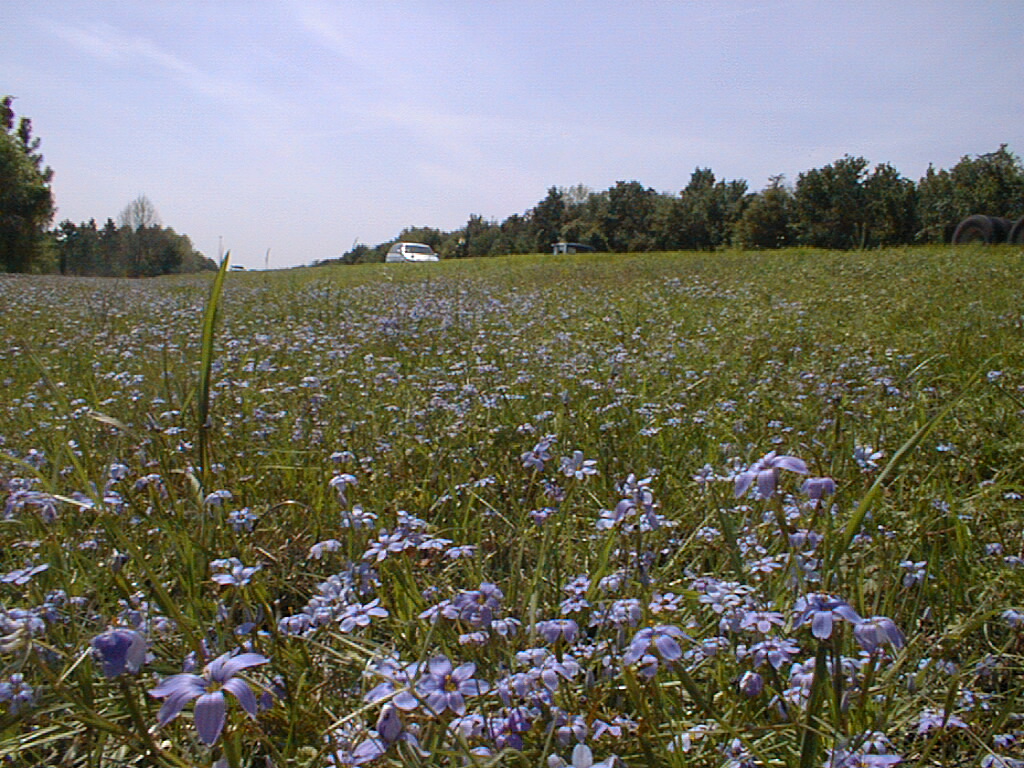Bloom Report: Early spring brings the blues
Pictured above: Blue-eyed grass (Sisyrinchium sp.) along I-75 near San Antonio. Photo by Jeff Norcini
The mild winter, adequate rain, and a warm beginning to spring has many wildflowers blooming a couple of weeks earlier than normal, the same as last spring. Expect the trend of earlier than normal flowering to continue as this spring may be warmer and wetter than normal according to the National Weather Service Climate Prediction Center.
A warmer than normal spring is not what many Floridians want to hear as that implies an early start to summer weather. For some relief, think cool, and the cool color of blue spring wildflowers. And by blue, think true blue.
Listed here are native wildflowers that are true blue (no hint of purple), as well those that can vary from true blue to purplish (or even white). Wildflowers that occur throughout the state will bloom earlier in south Florida than in north Florida. Most of the native wildflowers in this list occur on roadsides.
| Common name | Scientific name | Color1 | Bloom time | Region; Habitat |
|---|---|---|---|---|
| Fringed bluestar | Amsonia ciliata | true blue to nearly white | early to mid-spring | N, C dry, sandy areas |
| Whitemouth dayflower | Commelina erecta | true blue | late spring | N, C, S dry, sandy areas |
| Dixie iris | Iris hexagona | true blue | mid-spring | N, C, S moist areas |
| Blue flag iris | Iris viriginica | true blue | mid-spring | N, C moist areas |
| Toadflax | Linaria canadensis | true blue to purplish | late winter to early spring | N, C, S dry to slightly dry |
| Bay lobelia | Lobelia feayana | true blue to purplish | early to mid-spring | N (Madison County and east), C, S moist areas |
| Skyblue lupine | Lupinus diffusus | true blue | late winter to early spring | N (western Panhandle, peninsula), C, S dry, sandy areas |
| Narrowleaf blue-eyed grass2 | Sisyrinchium angustifolium | true blue, purplish, white | late winter to mid-spring | N, C, S moist areas |
| Jeweled blue-eyed grass2 | Sisynrichium nashii | true blue | early spring | N, C, S dry, sandy areas |
| Jeweled blue-eyed grass2 | Sisynrichium xerophyllum | true blue | early to mid-spring | N, C, S dry, sandy areas |
| Blue porterweed | Stachytarpheta jamaicensis | true blue, purplish | all year | C, S dry, sandy areas |
| Spiderwort | Tradescantia ohiensis | true blue, purplish, white | late winter to late spring | N, C slightly dry to slightly moist areas |
| Hairyflower spiderwort | Tradescantia hirsutiflora | true blue, rose | late winter to late spring | N (Pahandle) dry, sandy areas |
1 Known colors
2 Not a grass; member of Iris family
When you are out and about, enjoying the spring beauty that Mother Nature has blessed us with, please don’t pick wildflowers. If you want to preserve the memory of a wildflower, take a picture — it will last longer. Many of our native wildflowers reproduce only by seed. Picking a flower reduces the ability of that plant to reproduce and for that population of wildflowers to sustain itself. If you want to pick wildflowers, plant some in your yard or in containers on your patio or porch. Wildflower seed packets are available from the Florida Wildflower Seed and Plant Growers Association. Click here for seed packet availability and ordering. Seed packets of Florida native wildflowers also may be available at garden centers specializing in Florida native plants. To find a native garden center near you, visit the Florida Association of Native Nurseries’ web site.
For specific locations to view wildflowers, drive along one of the wildflower routes developed by the Foundation:
- Panhandle Wildflower Route: Liberty County, which includes SR 65 from Telogia to Sumatra, continues to be the best place in Florida to view native wildflowers.
- Panhandle Brochure: Includes the Panhandle Wildflower Route plus other roads in the eastern panhandle to view wildflowers. The brochure opens up to 18 x 24 inches, with one side featuring photos and information abut 40+ native wildflowers.
- Johns River to the Sea Bike Loop: Volusia, Brevard, Flagler, Putnam, and St. Johns counties.
- Big Bend Wildflower Route: Dixie, Gilchrist, Lafayette, Levy, Suwannee, and Taylor counties.
- Corkscrew Swamp Vicinity Wildflower Route: Collier, Hendry and Lee counties.
For more information about these routes, visit the Foundation’s Research page and scroll down to the report links.
Dr. Jeff Norcini has a consulting business, OecoHort, LLC, and is FDOT’s wildflower specialist, Tallahassee.

